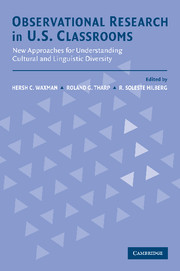 Observational Research in U.S. Classrooms
Observational Research in U.S. Classrooms Findings from an Observational Study of Success for All
Published online by Cambridge University Press: 23 November 2009
Improving teaching and learning, especially for culturally and linguistically diverse students, has been a constant goal of the education community. We have learned much over the past few decades, and every new reform addresses some aspect of schooling thought to affect outcomes for students. In many states and districts, standards have been raised, teacher professional development has been expanded, and changes in school governance have given more decision-making authority to educators at the school level. But as Elmore (1996) and others have noted, for a school reform to have results, it must affect what goes on in the classroom. The classroom is the locus of teaching and learning, and yet we do not know much about what school reform looks like at the classroom level. Systematic, guided observation is the best way to explore what happens in classrooms, and whether reforms result in changes in instruction and increased student engagement and learning.
This study illustrates the use of both qualitative and quantitative classroom observation methods in a study of one model of school reform, Success for All (SFA), that is being implemented in hundreds of elementary schools across the United States and abroad. As will be described, SFA reorganizes time and resources to provide rich reading instruction for all children. In this chapter, we use our dual methodological approach to explore what that reorganization and a new reading curriculum mean for teachers and students: how teachers' practices change and whether those changes result in improved student engagement and learning.
To save this book to your Kindle, first ensure [email protected] is added to your Approved Personal Document E-mail List under your Personal Document Settings on the Manage Your Content and Devices page of your Amazon account. Then enter the ‘name’ part of your Kindle email address below. Find out more about saving to your Kindle.
Note you can select to save to either the @free.kindle.com or @kindle.com variations. ‘@free.kindle.com’ emails are free but can only be saved to your device when it is connected to wi-fi. ‘@kindle.com’ emails can be delivered even when you are not connected to wi-fi, but note that service fees apply.
Find out more about the Kindle Personal Document Service.
To save content items to your account, please confirm that you agree to abide by our usage policies. If this is the first time you use this feature, you will be asked to authorise Cambridge Core to connect with your account. Find out more about saving content to Dropbox.
To save content items to your account, please confirm that you agree to abide by our usage policies. If this is the first time you use this feature, you will be asked to authorise Cambridge Core to connect with your account. Find out more about saving content to Google Drive.